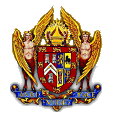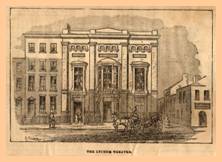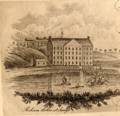
| | HOME | |
|
|
|
A History of Chapter of Strict Benevolence No 97
|
WE SINCERELY HOPE THAT THIS WILL LEAD YOU TO FURTHER YOUR INTEREST IN FREEMASONARY IN GENERAL AND ROYAL ARCH MASONRY IN PARTICULAR. If you are interested please contact us. |
Introduction to History
The History of Chapter of Strict Benevolence is a long one - its Charter granted and the Chapter constituted in March 1797 as Chapter of Strict Benevolence No 103......
205 years ago!!
Because this Chapter had a 13-year break in its continuity of working, between June 1839 and 6th September 1852, we can only claim recognition of one hundred years of continuous existence from the latter date.
Nevertheless Chapter of Strict Benevolence did come into being in 1797 and, despite the dearth of official records initially in the possession of the Chapter, we felt it right that on this auspicious occasion we should at least attempt to use whatever information came to hand to seek out the characters involved and the train of events which occurred to bring our Chapter into existence, and to show that despite the trials and tribulations en route we have ended up flourishing to this day.
Michael Scarth and Sea Captain’s Lodge No 144
On 13th October 1791 Mr Michael Scarth, a candidate for Freemasonry, was Initiated, Passed and Raised into Sea Captains Lodge No 144 in the King’s Head Hotel, High Street, Sunderland near the Sea. The publican Hays being his proposer.
In itself there is nothing unusual in this event as Sea Captains’ Lodge had been active in Freemasonry since 1757 and at that time it, like many other Lodges, was unnamed but officially known as No 218. The locals however knew it as the Marquis of Carnarvon Lodge, being derived from the name of the Inn where the lodge met in those days.
But it would appear that Bro Scarth himself was rather unusual, a man quick to action, a very able administrator and undoubtedly a leader of men. We feel it is worthwhile therefore to trace his influence and effect on the policies and events of the Sea Captains’ Lodge from the time of his Initiation through to the year 1797 when Chapter of Strict Benevolence was first formed.
Just about two months after his Initiation Bro Scarth was appointed Treasurer of the Lodge and immediately put forward the proposal that a committee of 5 members be appointed to examine the By-Laws and Accounts.
The Committee was appointed and he was one of the 5.
The By-Laws were quickly drafted and approved and in a short period of time presented to the Lodge by Bro Scarth not printed but handwritten, contained in a handsomely bound book which all of the brethren then signed.
By December 1792, a little over a year since he was initiated into the Lodge, he became Master.
Less than one month later and after he had obtained the necessary Dispensation, the lodge was opened in due form, a candidate Initiated, after which the officers and brethren, including the new candidate, dressed in full Masonic costume formed a torchlight procession. Then, accompanied by a band playing martial music, and escorted by a number of Peace Officers they proceeded to the Theatre situated in Drury Lane just off the High Street, to see performances of:-
“The True Born Tar” and “Appearance Is Against Them.”
A Mr Cawdell was the manager of the Theatre at this time.
NB Drury Lane still exists but is now composed of modern, brick, terraced maisonettes.
Charles Dickens acted in this theatre and the great Sir Henry Irving made his professional debut in 1856 here. The Theatre was probably demolished in the 1830s.
Fig.1 C 203 Robinson Library The Lyceum Theatre – Lambton Street This built at a later date – probably prior 1840 –and more than likely replaced the Drury Lane one. |
It is worthy of note that one distinguished visitor to this meeting, who later became a Joining Member was Bro Milbanke, a member of Marquis of Granby Lodge, Old Elvet, Durham who later became Provincial Grand Master in 1799 – Sir Ralph Milbanke, Bt. (Father of Lady Ann Isabella Milbanke who married Lord Byron at Seaham Hall in 1815).
In July 1794 because the brethren of Sea Captains Lodge were concerned that good feelings should exist between themselves and the brethren of the other Moderns Lodge in the town, namely Phoenix Lodge No 121, Articles of Agreement were drawn up by the Master of Sea Captains Lodge, Bro Michael Scarth (by now ProvJGW) and the Master of Phoenix Lodge Dr Tipping Brown (ProvSGW).
It would seem that these Articles were only partially, and perhaps half-heartedly implemented and then only for a relatively short while.
The Durham Connection
Note has previously been made that Bro Milbanke, and indeed other members of Marquis of Granby Lodge, were visitors to Sea Captains’ Lodge for there appeared to be strong bonds between these two Lodges stretching back for many years. But the first intimation that we have of any possible ‘Royal Arch’ connection between them is given in the Minute Book of the Marquis of Granby Lodge No 124 dated March 1775 where it records that 7 brethren from St Andrew’s Royal Arch, Scotland visited the Lodge. Also visiting that evening were two unnamed brethren from Sea Captains Lodge, Sunderland.
As this was an emergency meeting, with no work recorded, it is not known if they worked a Royal Arch meeting. It would have been an irregular meeting in any case as the degree was not recognized by their Grand Lodge. It was twelve years or so later that Chapter of Concord No 124, attached to the Marquis of Granby Lodge, was granted its regular Charter.
However, in the records of Chapter of Concord we later come across these entries of brethren exalted in the Durham Chapter meeting in Old Elvert :-
 |
7th February 1794 Michael Scarth, a gentleman of Castle Eden. |
|
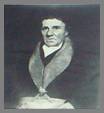 |
13th August 1794 Richard Wright, a cordwainer of Sunderland. |
|
|
13th August 1794 John Hewitt, a cabinetmaker of Sunderland. |
Several years later these 3 companions applied for and obtained a Warrant to form a regular Chapter, Strict Benevolence No 103 in March 1797.
Given the rapid progress and high advancement achieved by Bro Scarth since his Initiation in 1791, given his drive and the influence he seems to have exerted in Sea Captains Lodge, it would be difficult not to see him as any other but the founding father and initial First Principal of this Chapter of Strict Benevolence No 103.
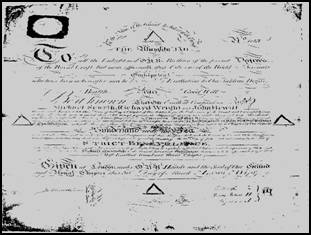
Fig.2 - Copy of Original Warrant of Chapter of Strict Benevolence
Numbered 103
Preserved in the archives of Supreme Grand Chapter
Although no record can be found of the Consecration of the Chapter the Warrant is preserved in the archives of Supreme Grand Chapter and has on it only the names of the three Principals i.e. Scarth, Wright and Hewitt and is signed by Lord Radcliffe , Henry Hobart and J Bodwin .
In the Register Book of the “Moderns” Grand Chapter it is stated that the Chapter was to be held at the Phoenix Hall, Sunderland near the Sea, on the third Thursdays in alternate months, the Chapter to be opened on Thursday 20th July 1797. At that first meeting in July six brethren were exalted namely:-
- T Hardcastle a Boat builder
- G Barker an Attorney
- G Allison a Watchmaker
- E Newton a Taylor
- W Tarn a Painter
- A Carr a Dye
Courtesy of Phoenix Hall Management
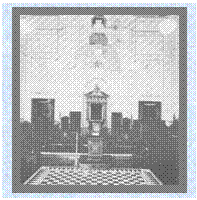 Fig.3 Fig.3 |
Prior to this first meeting an entry in the Minute Book of Phoenix Lodge No 94 dated 6th July details the conditions, payments etc. where the Lodge had favourably considered an application made by Bros Scarth, Wright and Hewitt and several members of this Lodge (Phoenix) for the liberty and use of this hall etc. etc. but ends with this rather stern comment: -
“it is to be understood that the said Royal Arch Chapter is not to be considered as connected to either this or the Sea Captains Lodge in any manner whatever” Three years previous to this statement Bro Scarth had been a prime mover in drawing up Articles of Agreement to bring the two lodges closer together and, as he was now Z of the newly formed Chapter and would be seen as a very strong character were others now apprehensively drawing a line in the sand? |
 Fig.4 Fig.4 |
From a Phoenix Lodge source we find that the Floor Cloth of the Royal Arch, which we are given to understand had been used since 1772 when this degree was practised under their Craft Warrant, was then loaned to the new Strict Benevolence Chapter formed by members of the Phoenix and Sea Captains’ old Royal Arches, presumably as a unifying and inspiring emblem.
Sadly we have no records of the first formative years of the Chapter and we lose touch with Companion Michael Scarth at this point in time, but in the wider world of Freemasonry the Union of the two Grand Lodges “Moderns” and “Ancients” took place in December 1813 under the title: -
More locally we learn that in September 1816 the proposal to unite Sea Captains’ Lodge and Phoenix Lodge under the title of “Phoenix and Sea Captains’ Lodge” was negated!!
A further 3 years later in 1819 the Royal Arch Masons in the Phoenix Lodge were granted a Charter, and the Chapter was consecrated in the following year as Chapter De Lambton.
On the Union of the Grand Chapters in 1821 it was decreed that each Chapter had to be attached to a particular lodge and in 1822 Chapter of Strict Benevolence No103 was officially attached to Sea Captains’ Lodge now numbered 153. The Charter of confirmation was however dated back to 7th November 1821.
Difficult period for Chapter of Strict Benevolence
We can see therefore that in just a few years the situation had changed dramatically for these two Lodges. From a position of them having joint membership in Chapter of Strict Benevolence and a proposal to unite the two Moderns lodges as one they were now each with their own attached Chapters and the proposal to unite had been quashed.
In the immediate years following this situation we can only conjecture what was happening in the Chapter of Strict Benevolence.
Certainly the depletion of numbers would not have been helpful, but what we do know, is that between 1826 and 1829 there was a relatively small break in the continuity of the working of the Chapter.
From the archives of Durham Provincial office two Minute Books of Chapter of Strict Benevolence were examined and shed much needed light on the period between 1830 and 1886.
The entry on Page 1 in the earlier Minute Book shows that a meeting took place in The Sea Captains’ Lodge Room, Hays’ Golden Lion, Sunderland on 7th January 1830 and records this opening statement:-
“ It having been a subject of much regret to many Companions of this Chapter, that its meetings had of late years, been of such irregular and infrequent occurrence, the following members assembled this evening, for the purpose of endeavouring to re-establish the regular Convocations.”
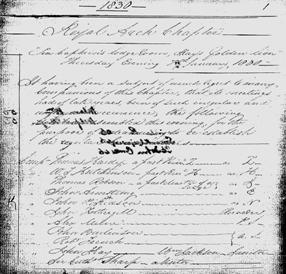 |
Fig.5 - Copy of Page 1 of the Chapter’s earliest available Minute Book. NB “Sir Cuthbert Sharp a Visitor” Durham and a Past Master of Sea Captains’ Lodge. Sir Cuthbert was then proposed and accepted as a Joining Member of the Chapter. Elections then took place for officers to serve for the present year, Sir Cuthbert Sharp being elected as Third Principal. |
Sir Cuthbert did not actually serve as 3rd Prin, other members acting in his place, and indeed there is no mention of him again until the meeting of April 1833 when he was elected as Second Principal and thereafter other qualified members substituted for him until 16th June 1835 at which meeting he occupied that Chair for the first time.
At the election of officers later in that meeting he was elected as First Principal.
Meetings of no great moment followed until October 1837 when with Sir Cuthbert still First Principal Bro R Tempest, Major of 60th Regt and of Lodge of Friendship No 345 (Gibraltar) together with Sir Hedworth Williamson, 7th Baronet were exalted into the Royal Arch Degree.
Only 5 more meetings were held between Sir Hedworth being exalted and the fateful meeting detailed later but there is no record that he attended any of these.
On Page 32 of this Minute Book it is recorded that on May 29th 1839, the last regular Convocation prior to the13 year break, with Sir Cuthbert Sharp still in the office of First Principal, all officers chairs were filled and 6 companions and 2 visitors present to see three brethren from Palatine Lodge exalted.
Companions were then appointed Officers for the ensuing year:-
The three Principals being:-
- W Hindmarch, 1st
- Sir C Sharp, 2nd
- Sir Hedworth Williamson, Bt., 3rd
The Lecture was given and the Chapter closed in due form.
A little over a week later, 6th June 1839, it is recorded on the very next page that six Companions met to examine the accounts of the late Treasurer, Comp Armstrong and to report thereon. The accounts were examined and allowed and a balance of £27.16.3 was passed over to the new Treasurer, probably Comp Edward Smith.
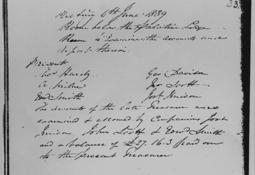 |
However, it is interesting to note that over the previous 9 years 25 meetings had taken place (almost 3 per year) and 28 candidates were exalted (1 per meeting), whilst over the last 10 meetings almost 2 candidates per meeting were exalted.
The reputation and standing of the Chapter must also have been quite high as in recent times many well placed brethren had been exalted such as, Bro John George Biss, MP for Northallerton, Bro R Tempest, Major 60th Regt., The Hon. John Locelyn, 30th Regt., and of course Sir Hedworth Williamson, 7th Baronet. |
Fig.6 - Minute of meeting held 6th June 1839 This then was the last official act of this difficult period in the existence of the Chapter. |
How then could the Chapter with a baronet and a knight elected among a full list of officers, attracting candidates of all classes and professions and found to be financially sound from a recent audit just disappear for 13 years?
Whatever may have been the views, or feelings, of any aspiring or ambitious companions during those nine years of the rejuvenated Chapter, as to their chances of progression, the plain facts are that during the first 3 years of the decade Sir Cuthbert had occupied the post of 3rd Prin, for the next 2 that of 2nd Prin and for the last 4 that of 1st Prin.
He was now again elected as 2nd Prin and Sir Hedworth as 3rd Prin !!
But for whatever reason, something really serious must have happened, away from the Chapter Room and before the next scheduled meeting, to cause the working of the Chapter to cease. Sir Hedworth, who later served in the office of ProvGM of Durham, from 1841 to 1845, was not therefore installed into the chair of 3rd Prin in this Chapter and almost half a century would pass before Sir Hedworth Williamson the 8th Baronet did occupy that chair and then in rather unusual circumstances.
After the Thirteen-Year Break |
On Page 34 the Minutes of the next regular Convocation are recorded as being held in the Palatine Lodge Room on 6th September 1852.
The Most Excellent Grand Superintendent, E Companion John Fawcett was in the chair of Z for the opening of the meeting with the posts of H, J, SE, SN, PS, 2xASojs and Treasurer filled by companions who, 13 years previously, had been Officers or members at the May 1839 meeting indicating, it appears, a loyalty and faith in the Chapter beyond the normal. Obviously there was no record that they had resigned or whatever 13 years previously, but here they were as a body, taking office as if nothing untoward or unusual had taken place.
At the election of Officers for the ensuing year, members who had attended the 1839 meeting again filled 2nd Prin, 3rd Prin, 2ASoj and Treasurer.
It would seem that the 13-year break in continuity was not the result of apathy at that time, not the result of lack of candidates or members of masonic quality and loyalty but rather from some unknown but very serious event. The late Treasurer's accounts had been examined and allowed at the special meeting of 6th June 1839 and no comment was otherwise made. What had been the cause of his death?
An economic depression hung over the nation in 1837 and the workhouses would have had many additional occupants as a consequence.
It is interesting to note that the Revd. Robert Gray, who was the well-respected rector of Sunderland, died from typhus in 1838 due to his work in visiting the sick.
The insanitary and overcrowded conditions in the Port of Sunderland would have made ideal conditions for the flea spread typhus disease, particularly during the nations’ influenza and typhoid epidemics of 1837 and 1838. Had these conditions persisted long enough to cause concern among the members?
Outbreaks of typhoid fever were not uncommon; indeed Michael Scarth himself had died from this disease back in 1805 and an outbreak of cholera presumably occurred in 1849.
The Public Health Act following on from these epidemics did not come into being until 1848 and required proper fresh water, sewerage, street cleaning and refuse collecting to be supervised by local boards.
By this time in the history of the Port of Sunderland the more affluent townspeople had move away from the port area and to the west whilst the meeting places for the town's lodges and this Chapter remained firmly entrenched in the squalid area populated by immigrant Scottish and Irish workers attracted by the work available in the quickly expanding township. Obviously the recommendations of the 1848 Public Health Act would not be implemented immediately and certainly Nelson Wake the Inspector appointed for Sunderland under the Act was able to describe in graphic detail the innumerable open sewers and cess pits in this area of the town.
The major outbreaks of cholera, typhus and killer 'flu are of course well documented but in a bustling port with appalling living and working conditions death and disease would never be far away and must, at times, had a strong influence on masonic attendance.
So it is on this date, 6th September 1852 that we started the 150 year journey to now receiving our Centenary Warrant, a journey not without note - one milestone being that consequent on the closing up of the numbers of Chapters in 1863 Chapter of Strict Benevolence now stands on the Register of Supreme Grand Chapter as No 97. But without doubt the most interesting and notable event took place at the meeting of 5th February 1886.
You may recall that Sir Hedworth Williamson, 7th Baronet was exalted into Chapter of Strict Benevolence in October 1837 and elected as Third Principal in May 1839.
Regretfully he never occupied that office for reasons recorded earlier but Sir Hedworth Williamson 8th Baronet, Provincial Grand Master of Durham did, for under a Dispensation given at Freemasons’ Hall, London on 8th day of December 1885, by Command of H R H, The Prince of Wales, K G etc. etc. M E Grand Z, it stated: -
“You having represented to the Most Excellent, The First Grand Principal of Royal Arch Masons of England that it would tend greatly to the advantage of your Chapter and promote the interests of the said Order to be permitted to Instal into the Chair of First Principal of your Chapter Companion Sir Hedworth Williamson, Baronet, who has not served in either of the Principal Chairs but is otherwise duly qualified and have prayed a Dispensation to authorize you to Instal the said Companion Sir Hedworth Williamson into the First Principal’s Chair etc .”
E Comp Benjamin Levy, PZ, PGH then installed Comp Sir Hedworth consecutively into the Chairs of Third, Second and First Principal in the ceremony held in the Park Terrace Masonic Temple (the façade now being rebuilt at Beamish Museum) on18th February 1886 starting at 4.00 pm. with 30 members and 30 guests in attendance. Dinner was in the Banqueting Hall at 6.30 pm - Tickets 6 shillings each.
At a later meeting E Comp Levy, PZ, PPrGH informed the Companions of the Chapter that he had had the honour of Installing Most E Comp Sir Hedworth Williamson, Baronet, First Principal of this Chapter as Provincial Grand Superintendent of Durham.
We have previously stated that the first entry in our remaining Record Book is dated May 1887 and therefore any other record book existing before that date must necessarily have been lost just prior to that entry.
Whilst we have no firm historical evidence as to how this record book may have been lost, the tale has been told for many years that the Scribe Ezra on that occasion unfortunately decided to leave this mortal coil, and the Chapter records, to the tender mercy of his spouse whose religious persuasion, it appears, had never been wholly compatible with his Masonic endeavours. It seems that several of the records were thrown out by that good lady!!
E Comp John Edward Westgarth-Walker, MBE, PGStB, PPrGSoj, Jeweller and Silversmith of Sunderland was affectionately known as “Johnnie” to members of this Chapter and many others. A member of Lambton Lodge No 375 he was exalted into the Chapter on 18th March 1943 at the age of 36 years becoming MEZ in 1957 and serving as Scribe Ezra of this Chapter for 25 years.
History must also record that on the occasion of his death on 26th December 1989 for the second known time some of the remaining Chapter records were lost, though possibly through no fault of his, but without doubt his Companions and many others will remember him only with a smile on their lips for he was a most charming, amusing and eccentric character who added much to the colour and relaxed nature of this Chapter.
We have been privileged to have had many distinguished companions as members of this Chapter, members who have excelled also in other branches of masonry and in their chosen professions viz:-
PROVINCIAL GRAND SUPERINTENDENTS OF DURHAM
- 1886 Sir Hedworth Williamson, 8th Bart.
- 1935 and 1936 R W Ernest Dixon and ProvGScribeE 1921 to 1934
- 1970 J MacMurray and ProvGScribeE 1948 to 1958
PROVINCIAL GRAND MASTERS OF DURHAM
- 1841 Sir Hedworth Williamson, 7th Bart.
- 1845 Sir Hedworth Williamson, 8th Bart.
- 1935 Cuthbert Wilkinson
- 1936 R W Ernest Dixon
DEPUTY PROVINCIAL GRAND MASTERS OF DURHAM
- 1832 Sir Cuthbert Sharp
- 1867 Sir Hedworth Williamson, 8th Bart.
- 1925 Cuthbert Wilkinson
- 1935 R W Ernest Dixon
- 1969 J MacMurray
ASSISTANT PROVINCIAL GRAND MASTERS OF DURHAM
- 1959 J MacMurray
- 1960 S Hudson
- 1989 F Westwick
- 1998 C S Barnett
PROVINCIAL GRAND SECRETARIES
- 1919 R W Ernest Dixon
- 1948 J MacMurray
However, no contemporary history of this Chapter would be complete without reference to our Director of Ceremonies E Comp Frank Westwick, PAGSoj, PPr2ndGPrin. Frank a member of Mowbray Lodge was exalted in this Chapter on 19th March 1964 and MEZ in 1975. He has served in the office of Director of Ceremonies with great distinction for over 21 years and undoubtedly his style and experience have greatly influenced the many Companions passing through the various offices of this Chapter.
In this story the names of Sea Captains’ Lodge and Phoenix Lodge have figured prominently in the forming of and the early history of Chapter of Strict Benevolence and as undoubtedly the catchment areas of Bishopwearmouth, Hendon etc provided many seafaring and allied professional members for these lodges and Chapters, so time and events have diluted this and today we have proud members of this Chapter derived from numerous lodges and districts and many diverse professions who combine to make the Chapter stronger whilst still maintaining the traditions of the past and the knowledge of our roots.
We hope that this short history has demonstrated that, whilst many of us were well acquainted with the fact that in 1797 masons from Sea Captains’Lodge and Phoenix Lodge came together to form this Chapter of Strict Benevolence, we were not so aware that there was a pre-history, so to speak, involving Marquis of Granby Lodge and Chapter of Concord No 124, that Bro Michael Scarth, PM (Sea Captains, Lodge) was our first ‘Z’, a man of action, a colourful man and most likely a man of some substance.
Companion Scarth’s Masonic descendant
This then would have spelt the end of this short history but on 30th August of this year (2002) I met with WBro Tom Smith, PPrGReg and a PM of Lodge of Concord No 6859 who is a direct descendant of E Companion Scarth’s youngest son of a family of 5 boys and 3 girls.
WBro Smith produced parts of the Family Tree and original documents showing that WBro Scarth was born on 10th October 1766, the illegitimate child of a man by the name of Stott, he married Ann Lane, a farmer’s daughter, at Castle Eden Church in 1791and died of typhus fever at the age of 39 years in Sunderland on 20th November 1805 being buried at Castle Eden.
WBro Smith was also able to produce many old documents dating from around the late 1700s some written in WBro Scarth’s own handwriting, but as he is Trustee of these and other mementoes he naturally does not wish them out of his possession or to subject them to any more photo copying processors.
However, we have been able to obtain a typewritten copy of a Biographical Sketch written in Scarth’s own hand for the information of his children.Fig.7.
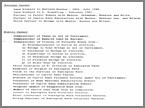 Click Image |
Michael Scarth was a partner in this business
|
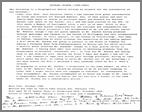 Click Image |
|
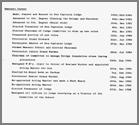 |
With an enthusiastic current membership of 62 and a fair complement of ritualists coming through the ranks, we raised our glasses at our 17th November 2005 meeting in tribute to our truly remarkable founder whilst looking forward to a long, happy and fruitful future.
Written and Compiled by E Comp, C H M Culkin, PZ, PPrGPrinSoj, Scribe Ezra To celebrate the Presentation of the Centenary Charter by |
Approved by the United Grand Lodge of England | Legal Notice
